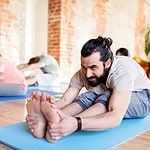Introduction
Knee pain is common in soccer players. To reduce the pain and risk of injury, improving balance and stability is key. Balance exercises target these muscles, strengthening them for optimal balance. This guide provides a few simple exercises for soccer players with knee pain. It’s best to consult a physical therapist for a tailored program.
Focusing on balance training regimens can improve overall performance and reduce the risk of knee injury.
Causes of Knee Pain
Soccer players often suffer from knee pain. This can be due to many things, such as overuse of the knee, an imbalance of muscles, or bad technique. To decide what to do about the pain, we need to identify the source.
Here are some of the most common causes of knee pain in soccer players:
Overuse
Knee pain in soccer players is often caused by overuse. Too much practice, tough competition and not enough training can lead to tendinitis, bursitis and patellar tendonitis. Imbalances between muscles can lead to joint damage too.
To prevent this, it’s important to warm up and stretch before activities. If a certain activity causes pain, stop until it goes away. Then start a balance exercise routine.
Weak muscles
Weakened muscles and ligaments around the knee can cause instability and an increased risk of injury. Causes of this include improper strength training, inadequate recovery from a prior injury, age-related muscle degeneration and muscular imbalances.
Symptoms can arise when weak muscles can’t support certain activities like running, jumping or turning quickly. To strengthen weak knee muscles, the soccer player should include balance drills in their routine. These include heel raises, hopping drills, and side step drills. All of these focus on strength training and coordination.
Poor technique
Poor technique or form while performing movements can lead to extra stress on the knee joint, causing knee pain. Poor technique in soccer – like kicking, pivoting, and changing direction – can cause too much strain on the joint. This can result in conditions like ACL tears, LCL strains, MCL tears, PFPS, and meniscal tears.
Injuries due to poor technique can be caused by a direct fall onto the knees or an incorrect landing during movement. Plus, bad training and warm-up practices can overload the knees and lead to overuse injuries like tendinitis and bursitis.
To prevent injury due to poor technique, soccer players should focus on balance exercises. This includes activities such as:
- Targeted stretching
- Strength training (squats, lunge variations)
- Plyometric drills (jump squats, box jumps)
- Balance drills (one-legged hops, single leg balance with stability ball)
- Agility patterning (lateral forward shuffles)
These exercises help soccer players maintain correct form when playing, avoiding potential issues down the line.
Exercises to Reduce Knee Pain
Soccer players? They’re prone to knee pain. Jumping, sprinting, turning – all can contribute. And it’s tricky to manage. Muscle imbalances and tightness are often to blame. So, exercises to reduce knee pain? It’s important!
In this article, we’ll delve into the best exercises for soccer players to tackle knee pain:
Strengthening Exercises
Strengthening exercises can be helpful for reducing knee pain and increasing strength, stability and balance. When done correctly and regularly, strengthening exercises can improve the overall health of your knees. Consider these exercises for reducing knee pain:
- Squats: Stand with feet shoulder-width apart, toes forward. Hold a pole or arm across chest for support. Lower yourself until thighs are level with the ground. Do not go below that. Push-off with your legs to return to starting position. Do 3 sets of 12 reps with a break in between.
- Wall Sit: Stand with back against wall. Place chair in front for support, if needed. Slide down into seated position with knees at a 90 degree angle. Hold for 30 seconds or as long as possible. Return to starting position slowly. Repeat 10-12 times per leg per session.
- Step ups: Place one foot on 2-3 inch block or step. Step up by pushing off that foot. Use hand weights for added resistance. But, avoid too much weight. Repeat 12-15 times per leg.
Do these simple strengthening exercises daily. Also, get physical therapy sessions. This is generally recommended by healthcare providers for knee pain conditions such as arthritis, tendonitis and post-injury pain.
Squats
Squats are a great way to get stronger in the hips and knees. Wear running shoes and knee sleeves for protection. To do a squat, follow these steps:
- Stand with feet hip-width apart.
- Turn the toes slightly outward.
- Lift the chest, pull down the shoulder blades, and tighten the abs.
- Lower the body until the thighs are parallel to the ground. Flexibility? Feel free to go lower, but take it slow and get help from a physical therapist or trainer.
- Push through the feet and come back up in a controlled way.
- Do 15-20 reps, starting with 2 sets.
For advanced squats: Do single leg squats. Stay on 1 foot/leg and switch every 3 reps. Don’t push past any pain.
Lunges
Lunges are a great way to gain strength in your quads and glutes, which can help reduce knee pain.
- Stand with feet hip-width apart.
- Step forward with the right leg, and bend the right knee till it’s at 90 degrees. The back leg should be slightly bent.
- Squeeze your glutes and press through the heel of the front foot to stand up. Go slow and repeat on the other side for 1 set of 10 reps.
- For an extra challenge, hold dumbbells in each hand either over head or at shoulder height. Keep weight evenly distributed from side to side when standing.
- Don’t let your back knee go lower than 90 degrees. This protects your knees from strain or injury.
Step-Ups
Step-ups are a great way to work on your quadriceps, hip flexors and glutes. Also, they can improve balance. People with knee issues may find that step-ups reduce stress on their joint.
To perform Step-Ups:
- Stand in front of a step that is 3 to 5 inches (7.5 to 12.7 cm) high.
- Put your left foot firmly on the edge of the step. Tap your right toes onto the top edge.
- Place your hands on either side of the step or across your chest/stomach for support.
- Push off with your left leg and rise up until your legs are at 90 degrees.
- Lower back to starting position and repeat 10 times for each leg.
- Rest for 1 minute then repeat for a total of 3 sets.
Balance Exercises
Balance exercises are great for soccer players with knee pain. They help strengthen muscles and increase flexibility. Plus, they can condition the body and reduce the risk of injury, as well as improve agility. Common balance exercises include: balancing on one foot, single-leg lifts, wall sits and mini squats.
Balancing on one foot is an exercise that can be done anywhere. Stand on one foot, with your other leg slightly bent. Tighten your abdominal muscles and keep your torso upright. Hold it for 15-30 seconds, then switch feet. This strengthens the glutes and core muscles, which will support the knees.
Single-leg lifts improve coordination and balance in a standing position with more movement. Start by standing with both feet flat on the ground. Shift all your weight onto one leg and lift its opposing foot off the ground. Hold for a brief moment, then switch legs. Do this 10 times, alternating left and right. This exercise increases strength and mobility around joints like knees.
A wall sit is great for strengthening the quads without putting strain on weak spots like the knees or ankles. Stand with your feet hip width apart and arms straight out. Slowly lower yourself until your back is against the wall. Hold for 45 seconds to a minute. Relax for 20 seconds between repetitions, and aim for 10 reps. This improves quadriceps strength and provides support and stability around joints like the ankle and knee.
Mini squats are great balance exercises that help improve posture and dynamic tasks like running drills. Stand with feet shoulder width apart and arms straight out. Bend at the waist, bringing your butt back. Lower until your thighs are parallel to the ground. Stand up, pushing off your heels. Repeat 12 times, 3 sets. Rest for 20 seconds between sets. Doing mini squats regularly increases dynamic stability and joint safety, preventing knee pain and injury.
Single-Leg Balance
Single-leg balance exercises can help you adjust and respond faster to changes in your balance. They also strengthen knee muscles.
- Stand close to a wall for support, but not touching it. Lift one foot and stand tall with your knee slightly bent. Keep your hip straight. Hold for 30-60 seconds and repeat 3-5 times.
- When without a wall, take up as much space as you need. Challenge yourself by increasing the time you hold the position. Work towards maintaining single-leg balance with eyes closed or while doing dynamic moves with one foot off the ground.
Standing on Foam
Foam is great for strengthening the muscles around your knees. Don’t be fooled by its gentle surface. Balance on a board or pad with both feet and arms outstretched for balance. Bend your knees ’till they’re just below parallel to the floor. Then, stand tall. It can help you focus on form and not strain your knee.
Do 10-15 reps, one-three days a week. Increase reps as desired.
Balance Board
The Balance Board exercise uses a balance board and a ball. It strengthens lower leg stability, as well as increasing range of motion.
To do the exercise, stand in the middle of the board. Put the soccer ball between your feet, slightly in front. Rock up and down on one foot, 10 seconds each way. Control your movements more and more as you go. You can add more repetitions for 15-30 seconds or add more weight.
For an extra challenge, try “ball jumps”. Jump onto the ball from one foot, then back to two feet. Stay balanced with both heels grounded. Make sure your knees stay flexed. 8-10 jumps should be enough to work up strength. Adjust if any discomfort arises.
Conclusion
Balance training is a must for any soccer player’s physical fitness. Coupled with other strategies, such as using knee supports and doing warmups, these exercises can help reduce the chances of a knee injury. Even though balance exercises can be hard, they should be done with caution and proper form.
No matter their experience or age, soccer players should use balance exercises in their workout routine. This can help them have great performance and less risk of getting a knee injury.
Frequently Asked Questions
Q: What exercises should soccer players with knee pain do?
A: Soccer players with knee pain should focus on balance exercises, such as single-leg squats, lateral shuffles, and single-leg hops. These exercises help to strengthen the muscles around the knee, which can reduce pain and improve stability.
Q: How often should soccer players with knee pain do balance exercises?
A: Soccer players with knee pain should aim to do balance exercises three times per week. Start with one set of 8-10 repetitions of each exercise, and gradually increase the number of sets and repetitions as the knee begins to heal and feel stronger.
Q: Are there any special precautions soccer players with knee pain should take when performing balance exercises?
A: Yes, soccer players with knee pain should always listen to their bodies and avoid any exercises that cause pain. It is also important to maintain good form throughout the exercises, in order to avoid further injury.





